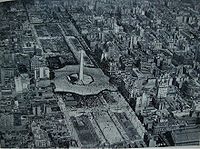
Florida Street is a popular shopping street in Downtown Buenos Aires, Argentina. A pedestrian street since 1971, some stretches have been pedestrianized since 1913.
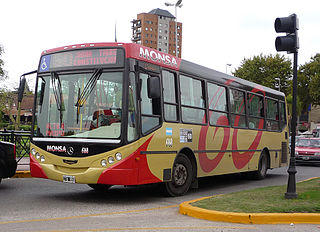
The Colectivo 60 commenced operations in 1931 and runs from Constitución station, in the centre of the city of Buenos Aires, Argentina to the Tigre Club in the partido of Tigre. The service is operated by Transportes Larrazabal C.I.S.A, DOTA and MOTSA and the identifying colour of the buses is white and red with black details.
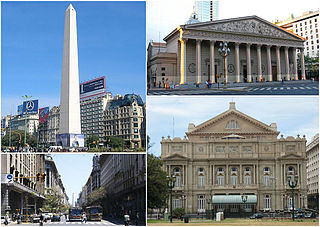
San Nicolás is one of the neighbourhoods of Buenos Aires, Argentina, sharing most of the city and national government Neighborhood of Buenos Aires with neighboring Montserrat and home to much of the financial sector. It is referred usually as El Centro, and the part east of the 9 de Julio Avenue is known as Microcentro.

Avenida Corrientes is one of the principal thoroughfares of the Argentine capital of Buenos Aires. The street is intimately tied to the tango and the porteño sense of identity. Like the parallel avenues Santa Fe, Córdoba, and San Juan, it takes its name from one of the Provinces of Argentina.

Plaza de la República is a city square in Buenos Aires, capital of Argentina. It is located in the San Nicolás quarter, at the intersection of the city's three main arteries: Ninth of July Avenue, Corrientes Avenue, and Diagonal Norte. It derives its name and associations from a church once sited on the square, San Nicolás de Bari, where the country's national flag was hoisted for the first time.
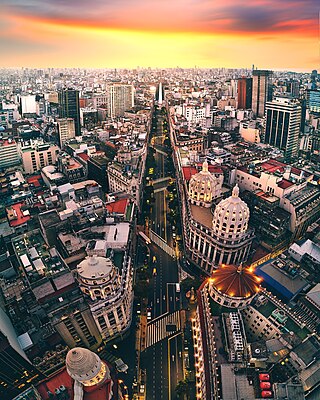
Avenida Roque Sáenz Peña, better known as Diagonal Norte, is an important avenue in the San Nicolás neighborhood of Buenos Aires, Argentina. It is oriented south-east/north-west, diagonally bisecting the city blocks (manzanas) which give the city centre a checkerboard plan. It is named after President Roque Sáenz Peña, who held power from 1910 to 1914 and passed the law which established universal suffrage, secret ballot and an electoral register.

Avenida Rivadavia is one of the principal thoroughfares in Buenos Aires, Argentina, extending 23 miles (37 km) from downtown Buenos Aires to the western suburb of Merlo. It is considered the third longest avenue in the world after Yonge Street (Toronto) and Western Avenue (Chicago).

Avenida Santa Fe is one of the principal thoroughfares in Buenos Aires, Argentina. The artery is essential to the imaginary axis of Barrio Norte in Buenos Aires, comprising the areas influenced by the route of the avenue through Retiro, Recoleta and Palermo neighborhoods, it is considered one of the main shopping and strolling areas of the city, its many boutiques range from elegant to edgy, which has led it to be dubbed the 'Avenue of Fashion'. Upscale Alto Palermo, at Avenida Coronel Díaz, is one of the city's best-known vertical malls. Avenida Santa Fe is also an attraction for its architecture, strongly reminiscent of Paris. Its name pays homage to the eponymous province in Argentina.

Córdoba Avenue is one of the principal thoroughfares in Buenos Aires, Argentina.

Alejandro Christophersen (1866–1946) was an Argentine architect and artist of Norwegian descent who designed many important buildings in the city of Buenos Aires, including the renowned Anchorena Palace.

Punto Obelisco is a zone around the Obelisk of Buenos Aires and the Plaza de la República. It is a project held by the city's government in order to enrich the surroundings of the monument and to make it the center of entertainment in the city. A zone combining the theatres avenue and the lights of LED signs taking inspiration from Times Square in New York City, the Shibuya Crossing in Tokyo and Piccadilly Circus in London and runs through Avenida 9 de Julio between Rivadavia Avenue and Córdoba Avenue. It also includes a ticket sales stand.

Carlos Pellegrini is a station on Line B of the Buenos Aires Underground. From here, passengers may transfer to the Diagonal Norte Station on Line C and the 9 de Julio Station on Line D and Metrobus 9 de Julio. The station was opened on 22 July 1931 as the eastern terminus of the extension of the line from Callao. In December 1931, the line was extended further east to Leandro N. Alem.
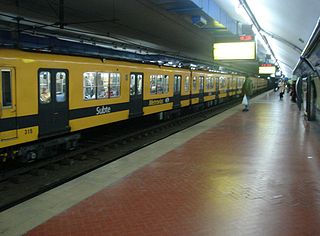
Diagonal Norte is a station on Line C of the Buenos Aires Underground. From here, passengers may transfer to Carlos Pellegrini Station on Line B or 9 de Julio Station on Line D and Metrobus 9 de Julio. It is located near the Obelisco de Buenos Aires.

Avenida de Mayo is a station on Line C of the Buenos Aires Underground. From here, passengers may transfer to Lima Station on Line A and Metrobus 9 de Julio. The station was opened on 9 November 1934 as part of the inaugural section of the line, from Constitución to Diagonal Norte.

Independencia is a station on Line C of the Buenos Aires Underground. From here, passengers may transfer to the Independencia Station on Line E and Metrobus 9 de Julio. The station was opened on 9 November 1934 as part of the inaugural section of the line, from Constitución to Diagonal Norte.

Independencia is a station on Line E of the Buenos Aires Underground. From here, passengers may transfer to the Independencia Station on Line C and Metrobus 9 de Julio. The station was opened on 24 April 1966 as part of the extension of the line from San José to Bolívar.

The Buenos Aires Metrobús is a 50.5 km (31.4 mi) network of dedicated separated lanes and stations for buses that serve the city of Buenos Aires, Argentina. Designed as a Bus Rapid Transit system, it mixes a few bi-articulated buses with conventional buses. The headway is the same as before the implementation of the system, and the buses on the system use the same brand as the main network, that is, maintaining their previous branding as common bus lines with their own numbers. The service operates 24 hours a day and 365 days a year, with 2-4 minute frequencies during the day and 10–15 minutes at night.

Avenida Pueyrredón is an avenue that runs through Recoleta and Balvanera neighborhoods of Buenos Aires, Argentina, and goes from southwest to northeast, parallel Avenida 9 de Julio. It starts at Avenida Rivadavia, and ends at Avenida Figueroa Alcorta.

Red de Expresos Regionales is a planned commuter network system in Buenos Aires, Consist in a tunnel connecting the 3 mainline railway stations of the city: Retiro, Constitucion and Once, in the north, south and west respectively, The new tunnels we have 2 new stations, the Central Station in the Obelisco and the Correo Central in these building, In Central Station a big interchange to the Underground network in the stations of Lima, Carlos Pellegrini, Diagonal Norte and Avenida de Mayo and 9 de Julio, and the Metrobus BRT network, In Correo Central a new interchange also to the Underground in the namesake station in B and E lines, These tunnels they will reconnect the network of commuters, disconnect since 1897 with the fire and clausure of the Buenos Aires Central Station, construyed by British company Buenos Aires Great Southern Railway and connection of the railways, a few meters of the Plaza de Mayo, The RER system we connect only the routes from Constitución, Retiro and Once, and electric
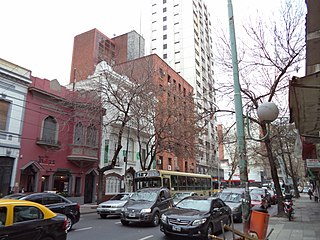
Avenida Medrano is an arterial road in Buenos Aires, Argentina. It was named after the politician Pedro Medrano. It runs through both the Almagro and Palermo neighborhoods. The arterial road runs northbound, with traffic going in the opposite direction. The avenue is characterized by its old banana grove, which was planted at the end of the 19th century. The trees protect the road from the sun during summer and are left completely bare after fall and during winter.

